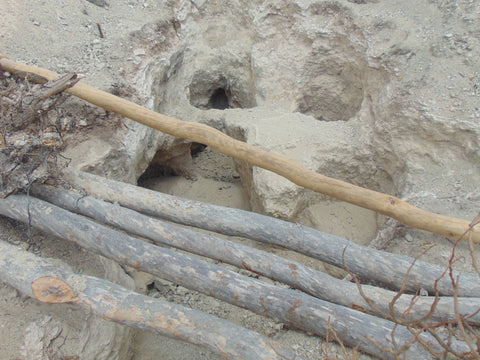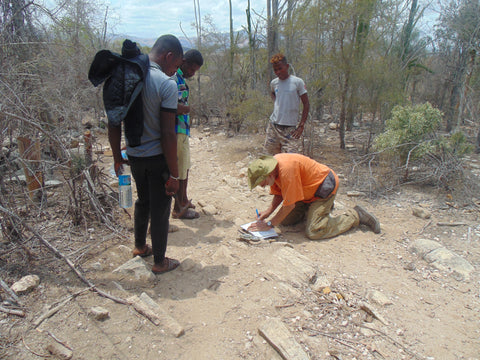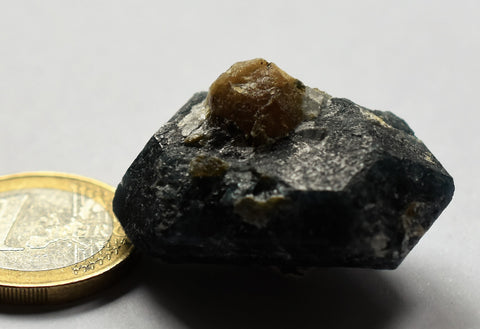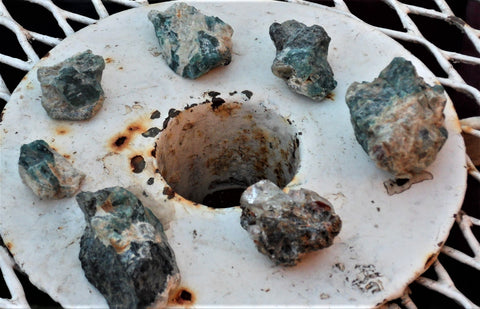For several years now, we have been finding three mineralogical rarities in respectable quantities in the deepest province of the Red Island, north of the picturesque port town of Tolagnaro (formerly Fort Dauphin): grandidierite, sapphirine and serendibite. Mindat.org lists many localities for this, almost all in the highly metamorphic Fort Dauphin series (or Androyen system) in the south of the island, but a huge area in terms of area. A problem for me was always to get the most exact location of these minerals, but either this was unknown to the sellers or they gave a nice name out of politeness (and checking this was simply impossible) or they wanted to keep the location secret to protect them not to lose to others.

magnificent freestanding Grandidierite crystals from southern Madagascar
Perhaps first something about the prehistory :
Grandidierite, already mentioned by LACROIX at the beginning of the 20th century, was rediscovered by BEHIER in 1960 in an old abandoned phlogopite mine, but it always remained a very rare mineral that was only sporadically offered in small, bad specimens. I was all the more astonished when, during a stay in Antsirabe in 2015, together with my American friend Mike Shannon (from Shannon Family Minerals, AZ, USA), a relatively large number of large pieces, albeit with very poor crystal faces, were offered.
the first larger quantities of grandidierite that were offered to me in 2015, pretty bad, eh
the iron table on which they lie
I made an agreement with the site owner to fund further exploration in exchange for first choice production. And indeed, over the next
a good cabochon quality Gandidierite crystal
years, the quality of the steps improved tremendously. There were very large crystals and excellent free-standing crystals. Even facettable grandidierites were found, also some of cabochon quality, these achieve top prices as collector's stones. However, many of these facetable stones often turned out to be beryls. However, the place of discovery was never given to me precisely, only names, all of which later turned out to be wrong and were only mentioned to mislead.

Magnificent specimen of large grandidierite crystals
A few years later, in November 2022, in Antsirabe, I was offered pieces of a mineral I had never seen before in Madagascar, namely serendibite. The mineral itself was known to me from Mogok in Burma and from the type locality in Sri Lanka (Serendib is the old Arabic name for this island), but not from Madagascar. A look at mindat.org confirms the occurrence in Madagascar. To check I let the mineral in
The first certificate of laboratory analysis of the Serendibit
examined in a gemological laboratory in Antananarivo and actually received the positive result: it is the extremely rare borosilicate serendibite. The owner of the site turned out to be the same as the grandidierite site. He reported that he accidentally found these crystals a few months ago and had dug about 3m deep in the meantime. The site would be around the town of Amboasary, about 70 km NW of Tolagnaro.
Now, however, back in Germany, the first analyzes by the EPI institute revealed sapphirin as a result, which was confirmed by further analyzes by two laboratories in the USA and an investigation by the mineralogical institute at the TU Berlin. So we must drop the term serendibit and instead keep sapphirin as the correct term.
We made the same deal as with the Grandidierites and I took the tiers gained so far, plus a batch of faceted sapphires and a small batch of faceted rough stones as well.
faceted sapphires found in the top part of the small abau
I would have liked to visit this site, but the owner refused to take me there, pointing out that the area was very unsafe due to bandits (" dahalo" in malgache ).
The first sapphirine crystals were very dark and the beautiful blue color could only be seen in exceptional cases. Also, the crystals were only rarely sharp-edged, the contours mostly blurred in the matrix of feldspar and phlogopite. The majority of the pieces showed some crystal faces, but hardly any complete crystals.
We also presented this first yield from December 2021 in this online shop. There were already faceted stones and faceted raw material, but the quantity was very small and should not increase in the future. They have remained the absolute exception to this day.
Unfortunately, when we wanted to return to Germany with our minerals in December 2021, this was no longer possible. Due to an unusually brazen smuggling affair by a Sri Lankan diplomat (he wanted to take 10 kg of the finest raw sapphire goods worth a few million dollars out of the country, declared as inferior garnets), the entire export of minerals, including collector's minerals, was banned. Ministers, customs officers and employees of the office de mines were imprisoned or fled the country. The restrictions were only lifted again in September 2022 under a new mining minister.
 typical example of a blue sapphire rich in feldspar found at deeper depths
typical example of a blue sapphire rich in feldspar found at deeper depths
In the meantime, the excavations in the Amboasary region have continued and we were constantly up to date through our partner Andoniaina Vololontiana. The owner, Monsieur Dieudonné Mahazomila, delivered the minerals produced to Mrs. Vololontiana in Antsirabe, as agreed, and we were pleased to see that the quality continued to improve. The colors now varied from light to dark blue, and crystals of ever better quality were mined with increasing depth.

excellent dark blue shiny sapphirine crystals, which are still very rare
Many crystals now had sharp edges, and the number of really good idiomorphic crystals was constantly growing. However, the percentage of these beautiful collectibles was still quite low at an estimated 20%. 80% were no longer very interesting from a collecting point of view.

faceted sapphires were only found in very small amounts and only at the beginning of the work
At some point, after much hesitation and concern, Monsieur Mahazomila was willing to show me the sapphirine deposit. We arranged the excursion for November 2022.
The Visit, November 2022
The distance on the road from Antsirabe to Tolagnaro is approx. 1200 km, of which 700 km are bad asphalt roads with many holes and 500 km are extremely bad tracks. A few years earlier we needed 3 days with robust four-wheel vehicles for the 500 km from Ihosy to Tolagnaro. Meanwhile, both road sections had not improved, quite the opposite. In addition, there is the constantly growing danger from bandits (dahalo), so that the trucks only drive in convoys or with military escort.

Detail from: Freytag & Berndt, Madagascar 1:800000, southern part with location of the discovery site
So only the plane remained. Mrs. Vololontiana sent her cousin, Rakotomalala Narindra Gael, a day ahead to rent a sturdy car in Tolagnaro, we both followed on 11/1/2022.
The Tsaradia Airline turboprop took us from Antananarivo to Tolognaro in 2 hours. This city is very picturesquely situated on a large bay, it is the supply point for the deep south of Madagascar, unfortunately due to the miserable infrastructure it is difficult to reach, except by air or by ship.
https://youtube.com/shorts/2ITWVZSBbYE?feature=share
Approach for landing on Tolagnaro (formerly Fort Dauphin)
In the afternoon we met Monsieur Mahazomila to discuss the trip to Amboasary. Now I heard for the first time that the site where the sapphirine was found is also that of the now numerous and very good grandidierites. He strongly advised us not to carry jewelry and only as little cash as necessary. We had already heard from acquaintances in Antsirabe and Antananarivo that the wider area around Amboasary, about 70 km NW of Tolagnaro, was also made unsafe by dahalo. He also asked not to buy any stones in the vicinity of the discovery site.

one of the many beautiful bays in Tolagnaro
The next day early in the morning we set off in a very sturdy four-wheeler. The track to Amboasary had gotten so bad since my last visit that it was almost unrecognizable. Remnants of asphalt alternated with deep ones

the good part of the road from Tolagnaro to Amboasary
potholes. We needed 2 hours for the 70 km and were happy about it. Our driver said a month ago he needed 7 more hours. Some holes were probably filled. I had a reunion with a small stall selling hand-carved animal figures where we had bought some nice figures in 2009. It is a small village community that makes these figures for buyers from the capital.

there are carved lemurs, chameleons, baobabs and more
In Amboasary, a pause was made in the house of Monsieur Mahazomila to allow friends of his to offer us the faceted Grandidierites I had asked for. Unfortunately, upon closer inspection, all reasonably transparent stones turned out to be beryl. M.Mahazomila also reported on the history of the deposit during the short break.

the village of Ampiha in the north of Amboasary
The first grandidierites were found superficially in the vicinity of the very small village of Ampiha, brought to Antananarivo and analyzed there. Later, after - as reported above - Mike Shannon and I received these grandidierites and the first money flowed, it was dug, as is usual in Madagascar, and the Madagascars are world champions in sinking small shafts. The entire area around Ampiha is owned by Monsieur Mahazomila's father, so the father has the right to determine who works there.
the busy center of Ampiha
However, there is always the danger that the office de mines (the Madagascar mining authority) can pass on the rights to third parties through bribery or good relations. This was also a reason, in addition to the insecurity caused by the bush robbers, that practically no foreigner is allowed to visit the area. So I found out in passing that I would be the first foreigner to visit the deposit.
Over the next few years, grandidierites were eagerly mined and numerous shafts were sunk, with great success. The yield got better every year.

on the march to the actual mining area
However, this also resulted in prices falling drastically. For as rare as the grandidierites were, they are not aesthetic beauties and demand is correspondingly limited. Although high prices are paid for very good faceted stones, the demand is manageable in this case too.
At the moment grandidierite is being searched in many shafts on a strip of approx. 300 mx 70 m. On the approximately 1.5 km long trail from Ampiha to the mining area you can see many small holes left and right in the bush, experimental prospecting that was given up again due to lack of success. In the actual mining area, characterized by many heaps,

the main mining field for grandidierite, numerous small shafts surrounded by spoil
which unfortunately, to my great chagrin, did not reveal the geology. These shafts are about 10 m deep, then the workers encounter the prospective zones. Around 60 kg of varying quality are promoted per week. In principle, anyone can dismantle Madasse. The inhabitants of Ampiha are allowed to do this without paying M.Mahazomila or his father

Mining trials can be found all around Ampiha
to have to pay, non-locals have to pay a fee depending on the quantity and quality of the finds. Most of this money goes to the village community. The number of people currently working there above and below ground is around 200. During my visit I could not confirm this number of people, only in a few shafts

in the mining area on grandidierite
was worked. The entire mining area strikes NE-SW and dips at 42 degrees SE.

Measuring the mica slate
Unfortunately, the geology could only be seen at the edge of the excavation field. Here are the highly metamorphic gneisses, which in turn host the pegmatites with plagioclase as the matrix, as well as phlogopite and grandidierite and, surprisingly, sapphirine.
This mineral has so far only been found at one point in the large mining area, a small spot on the edge, and that too only by accident.
from left to right: M.Dieudonné Mahazomila, Madame Andoniaina Vololontiana, Jochen Hintze
at the Sapphirin shaft. The blue fragments in the foreground are clearly visible
In May 2022, Monsieur Dieudonné Mahazomila discovered some small fragments of a blue mineral that he did not recognize. he gave these fragments to a well-known Malagasy mineral dealer. These pieces were later identified as Serendibit (which, as is now known, turned out to be incorrect).

perfect sapphirine crystal from Ampiha of beautiful blue colour
He quickly realized that the discovery of the blue mineral was extraordinary and only allowed a trustworthy man to work in the new shaft. At the time of my visit, the shaft was 8 m deep and underground the deposit had been approached by a 12 m long cross passage.
the owner of the sapphire mine, M.Dieudonné Mahazomila with his only worker
Unfortunately, I was not allowed access to the shaft, I would have loved to have answered my biggest question: I have already seen thousands of specimens with grandidierite and sapphirine, but never a piece with both minerals together. This is extremely surprising for mines that are only a few meters apart.

a magnificent perfect sapphirine crystal
After half an hour on the excavation site, Monsieur Mahazomila became noticeably restless and often asked if I had already seen enough. He refused my request to look at the rocks above the shafts, saying that it was now time to go back, there was nothing more to see and it also looked like it was going to rain (but I didn't think so). In the meantime, a few dozen men had gathered at a distance of 50-100 m, and their presence must have worried him. So we had to turn around with a heavy heart and leave the camp.
Despite the much too short time, it was a great experience to be the first foreigner to visit this fantastic deposit.
Upon my return, among the numerous crystals and tiers, I found 2 beautiful crystals with a second mineral. It is a very indistinct crystal of beige color with a greasy sheen. This mineral is currently at the Technical University of Berlin and has not yet been identified.







